INDIAN ARMED FORCES CHIEFS ON
OUR RELENTLESS AND FOCUSED PUBLISHING EFFORTS

SP Guide Publications puts forth a well compiled articulation of issues, pursuits and accomplishments of the Indian Army, over the years

I am confident that SP Guide Publications would continue to inform, inspire and influence.

My compliments to SP Guide Publications for informative and credible reportage on contemporary aerospace issues over the past six decades.
- Prime Minister witnesses 'Bharat Shakti' – a Tri-Services Firing and Manoeuvre Exercise in Pokhran, Rajasthan
- Interim Defence Budget 2024-25 — An Analysis
- Union Defence budget 2024
- Prime Minister Modi Commemorates Indian Navy Day in a Grand Ceremony
- Prime Minister Modi Flies in the LCA Tejas
- New Chapter in India-Italy Defence Ties
- Airpower beyond Boundaries
INS Vishakhapatnam – New era of force projection
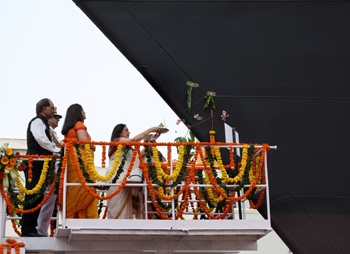
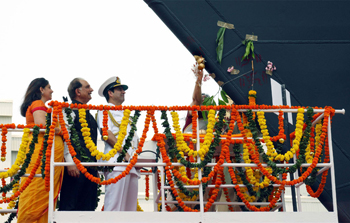
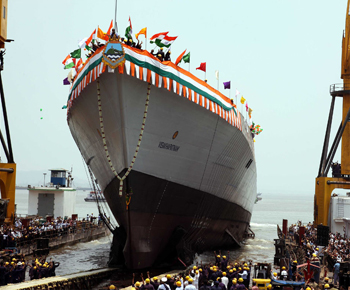
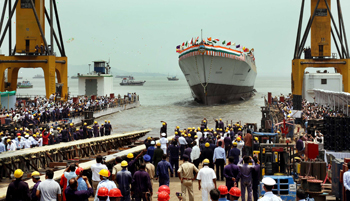
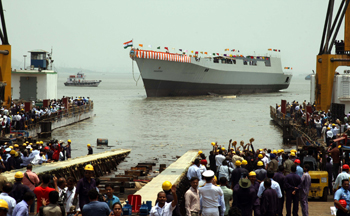
The latest Vishakhapatnam class of stealth guided missile destroyer would be one of the finest examples of ‘Make in India’ projects under implementation for the Indian Navy. Designed by the Directorate of Naval Design, this warship would herald Indian Navy in a new era of maritime force projection. Equipped with the most modern long range and cruise missiles the warship will not allow any enemy maritime movement in combat situation within a radius of 300 kms and has the ability to totally dominate the sea in its area. The ship will have enhanced stealth features that have been achieved through shaping and use of radar transparent deck fittings.
However, the Navy will have to wait for three more years. By July 2018 the Indian Navy will be get the world’s most power packed stealth destroyer. As a follow-on warship under Project 15-B of the Indian Navy, the 7,300-tonne warship INS Vishakhapatnam was launched on April 20, 2015 by Mrs Minu Dhowan, wife of the Chief of Naval Staff, Admiral R K Dhowan as per naval traditions. Speaking on the occasion Admiral Dhowan commended the joint efforts of various design, research and manufacturing entities for the massive project. He appreciated the efforts put in by the Directorate of Naval Design and also referred to the role played by the Defence Research and Development Organisation and said that all contribute towards achieving Indian Navy’s dream of transforming itself from a ‘buyers navy’ to a ‘builder’s navy’.
INS Vishakhapatnam would be much more advanced than India’s current most modern Kolkata class destroyers manufactured under project 15 A. INS Kolkata was delivered to the Indian Navy last year and two other ships of this class, Kochi and Chennai, are being built by Mazagon Dock ltd , Mumbai. Till date, the Kolkata class was the largest destroyer ever built at Mazagon Docks. However, when INS Vishakhapatnam is commissioned in July, 2018 it will become the largest ship to roll out of MDL.
The Kolkata class itself was the follow-on of Project 15, Delhi class destroyer (6,700 tonnes) under which three warships have been built and delivered to the Navy. INS Vishakhapatnam would be 65 per cent indigenous and will deploy a number of indigenously developed weapon systems.
According to the Director General of Naval Design, Rear Admiral A K Saxena “This is the first time virtual designing and 3D modelling have been used largely to design a warship. This ship will be a stepping stone for handling larger warships in future...,” The new destroyer with advanced stealth characteristics with better capability to operate in nuclear, biological and chemical atmosphere, will give a major fillip to India’s maritime capabilities when it is inducted in 2018. The keel of the first ship under Project 15 B was laid in October, 2013.
According to Rear Admiral Saxena, “the Kolkata class did not have a full-fledged ‘total atmospheric control system’ (TAC) . The TAC provides you with the capability of operating in a fall out region, be it a nuclear, biological or chemical. Because the complete air being taken inside is through, nuclear, biological and chemical filters except in the machinery department.” According to Saxena, “those entering the machinery department in a fall out region will have to wear specialized masks to protect themselves.”
With 7,300 tonnes displacement, INS Vishakhapatnam would be the largest Indian warship in its class and will carry 32 Barak-8 long range surface-to-air missiles, being jointly developed by India and Israel. Presently the Barak 8 missile is being deployed on INS Kolkata and will be flight tested by October this year. The ship will deploy the Israeli multi function surveillance threat alert radar (MF-STAR) which will provide targeting information to 32 Barak 8 long-range surface-to-air missiles.
The naval version of the Brahmos supersonic cruise missile, eight in number, are also planned to be deployed. The hull design and the Ukranian built Zorya gas turbines of Vishakhapatnam would be the same as in Project 15. Under Project 15 B some of the major improvements and additions have been done as compared to Kolkata class Project 15A. For example, the 127 mm main gun on Vishakhapatam would be much more powerful than the one on Kolkata which has only 76 mm super rapid gun mount (SRGM). Both class of ships would have similar AK-630 close-in anti missile gun system. The sonar deployed on Vishakhapatnam would be bow mounted and will have an improved bridge layout. The design of the mast featuring the main radar has been revised. The crew of Vishakhapatnam would have better safety provisions against nuclear, chemical and biological attack. It would be featuring a rail-less helicopter traversing system to secure the helicopter deployed in heavy sea conditions.
With an emphasis on indigenisation, some of the major systems and equipment to be deployed on the ship are: rocket launcher for anti submarine warfare (ASW) built by Larsen and Toubro (L&T); torpedo tube launcher for ASW; combat management system ( BEL); foldable hangar door; close in weapon systems ( Gun Shell factory and BEL); boat davits ( GRSE) ; integrated power management system ( L&T); bow mounted sonar and early warning system ( ELLORA) by BEL.
According to officials of the Directorate of Naval Design , the destroyer can truly be classified as a ‘network of networks’, as it is equipped with ship data network (SDN), automatic power management system ( APMS) and combat management system (CMS) , while remote control and monitoring of machinery is achieved through the integrated platform management system (IPMS), propulsion and power management is done using the APMS. The CMS performs threat evaluation and resource allocation based on the tactical picture compiled and ammunition available onboard.
INS Vishakhapatnam will be 163 metres long and 17.4 metres at the beam. Propelled by four gas turbines the ship is designed to achieve speed in excess of 30 knots. The ship will have an endurance of 4,000 nm at an economical speed of 14 knots. The ship will house 50 officers and 250 sailors and the accommodation and working spaces have been designed with special emphasis on ergonomics and habitability.
The three other warships under Project 15 B would be rolled out each after two years. A total of Rs 29,600 crores was sanctioned by the government for all the four ships. While the first ship has been named INS Vishakhapatnam, it is learnt that other two ships of this class would be named as INS Porbandar and INS Marmagao. The fourth ship of this class is likely to be named after a Gujarat port.
Thus by the end of 2024 Indian Navy would be projecting its devastating fire power in the Indian Ocean which will play a significant role in anti access and area denial to the rival warships in times of combat crisis. In fact, the ships under 15A and Project 15 are also equipped with equally capable fire power , the combat management system of the INS Vishakhapatnam class of ships which would enable Indian Navy to roam with ease not only in the Indian Ocean but also far beyond its maritime area of interest.





